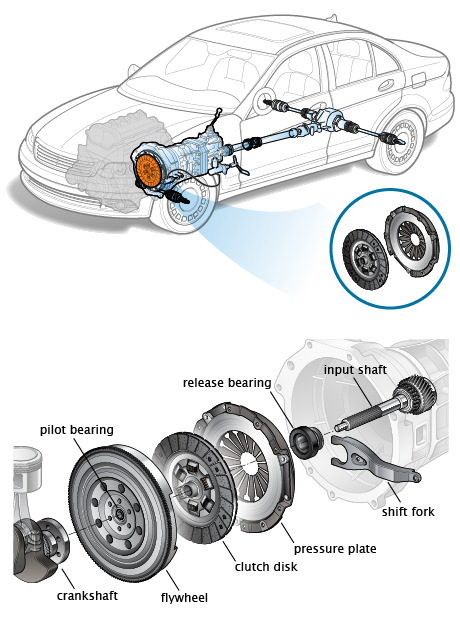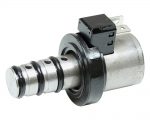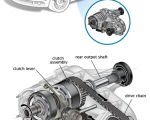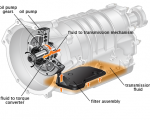How to Tell if Your Clutch Is Going Bad

A faulty clutch can cause a number of problems. These are some of the most common:
Clutch slippage: This is an increase in engine speed without an increase in vehicle speed. It typically happens when the clutch pedal is released after a gear change.
Chatter or grabbing: Clutch chatter or grabbing is felt as a jerking sensation when the clutch is engaged. This is a sign that the flywheel may be worn and should be inspected.
Noise: A faulty clutch can cause a number of noises. Growling or chirping when the clutch pedal is depressed is usually caused by a faulty release bearing. Grinding when the transmission is shifted can be caused by a worn clutch disc or pressure plate.
Hard shifting: A worn or damaged clutch may not completely disengage the engine from the transmission, resulting in hard shifting or clashing of gears. This will damage the gears in the transmission if you don’t address it quickly.
Clutch pedal feels loose: If your clutch pedal isn’t engaging as well as it usually does, this could be a sign that your hydraulic system has a leak, or that the clutch needs an adjustment.
Car won’t go into gear: If the clutch doesn’t disengage, the driver may not be able to shift the transmission from neutral into gear. This is a sign of a bad pressure plate, and requires that the car be towed to a mechanic.
Stalling: A faulty clutch can prevent the engine from disengaging from the transmission, causing the vehicle to stall.
» GET AN ESTIMATE: Learn how much a clutch replacement should cost you
How to fix the problem
A faulty clutch should be first diagnosed by a professional, then replaced. This is a big job that’s best left to a professional. Since the clutch is sandwiched between the engine and transmission, the entire transmission assembly or transaxle must be removed. In most cases, a hydraulic clutch system will need to be bled of air after the replacement. On front-wheel drive vehicles, an alignment may also need to be performed.
Engine oil from the clutch’s rear main seal or transmission fluid leaks from the input shaft bearing can damage a clutch. When replacing a clutch, any leaks should be diagnosed and repaired to avoid recurring problems. As a preventive measure, a shop may recommend replacing these two seals even if they’re not leaking — it’s good insurance against expensive future repairs.
Also, you should always avoid riding the clutch (resting your foot on the clutch pedal, not allowing it to release completely), as it can cause premature clutch failure.
What the clutch does
When you press the clutch pedal, the clutch disengages the engine from the transmission. This allows for smooth gear shifts and prevents the engine from stalling.
When your car comes to a stop, the engine keeps running. If the clutch doesn’t disconnect the engine from the transmission, the car will keep trying to send power to the wheels, and the engine will stall.
The clutch must also disconnect the engine from the transmission when you shift gears. Otherwise, engine power will still be flowing through the transmission during a gear change. This can make shifting difficult, or even impossible.
Get it diagnosed by a professional
Find a shop in your area
How the clutch works
The clutch is located between the engine and transmission. Two components make up the clutch set: the pressure plate and clutch disc.These two components are what are typically replaced during a basic “clutch job” (sometimes the release bearing is also included).
Clutch disc: The clutch disc is coated in friction material and located between the pressure plate and flywheel. It’s also connected to the transmission input shaft. When you’re not pressing the clutch pedal, the clutch disc turns with the flywheel and the engine. This causes the input shaft to turn, transferring engine power to the transmission.
Pressure plate: Mounted on the back of the flywheel, the pressure plate puts force on the clutch disc using coil springs or a diaphragm. This holds the disc against the flywheel, allowing power to flow from the engine to the transmission.
Several other parts work with the clutch set to provide smooth transmission operation:
Flywheel: The flywheel provides a mounting point for the clutch on the back of the engine’s crankshaft — if the engine is turning, the flywheel is turning.
Release bearing: Also called the throwout bearing, this typically is a sealed or roller bearing. It rides on the transmission input shaft bearing retainer (which goes around the input shaft) and disengages the clutch disc when you press the clutch pedal.
Release system: There are three different types of clutch release systems: mechanical, cable and hydraulic. They all serve the same purpose — to transfer clutch pedal input to the clutch assembly. Most vehicles made within the last 20 or 30 years have a hydraulic system.
نوشته های مشابه














